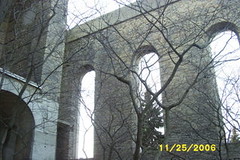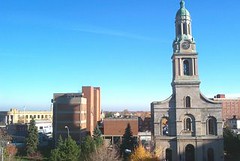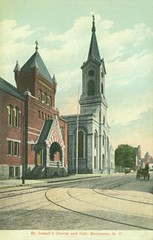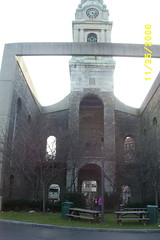I've been thinking outloud recently with a number of fixBuffalo readers, local preservationists and community planner types about the future of Transfiguration Church. Clearly, hope is not going to work in this case. Need something concrete to move forward.
_______________
update...12/4/06...1115am for additional Transfiguration Church background check out the growing list of comments over here - Inside Transfiguration, finally. Two additional DK Photogroup slide shows just showed up - Michele's and Laurin's. Sean added a few to his, too - right here.I tossed out the idea, low-level green space development with a partial demolition - right here, last week. Turns out that we don't have to go all the way to England and parts of Europe to see a brilliant example of this adaptive reuse that we should call, no sugar coating and pretending now...Church Ruins. In Rochester, NY we have an example in St. Joseph's Roman Catholic Church. fixBuffalo reader sent me a recent post - right here - All That Remains and here - Island of Grace, very nice timing, to a Cincinnati based blog, Ten Reasons. Both posts provide some very well timed information about the Rochester model. These pics are all lifted from those posts.
Here's a short history by Rochester Historian Vincent A. Lenti from the summer of 2001 - A History of St. Joseph's Roman Catholic Church [.pdf]. Excellent background about the social history of the parish and its German immigrant roots and information about the fire that destroyed the Church in 1974. The Landmark Society has recently published a book about Rochester's oldest Catholic Church, St. Joe's - The Oasis of Grace.
Here's a short history by Rochester Historian Vincent A. Lenti from the summer of 2001 - A History of St. Joseph's Roman Catholic Church [.pdf]. Excellent background about the social history of the parish and its German immigrant roots and information about the fire that destroyed the Church in 1974. The Landmark Society has recently published a book about Rochester's oldest Catholic Church, St. Joe's - The Oasis of Grace.
This approach, while creating a rather unique urban environment of course also pays homage to the legacy of religous architecture that still resonates with people, today. I imagine at least by preserving some of the structure, people at some place down the road may realize, perhaps more than we do today, the importance and continuity of religion and the role it plays in our lives.
Here, I am reminded of a few lines by John Dos Passos that appear in the work of what is no doubt our near East Side's most influential and important intellectual, Buffalo born historian Richard Hofstadter (1916-1970). The introduction to his American Political Tradition (1948), which boldly changed the way in which we still today think about our American story, contains the following lines by Dos Passos:
Here, I am reminded of a few lines by John Dos Passos that appear in the work of what is no doubt our near East Side's most influential and important intellectual, Buffalo born historian Richard Hofstadter (1916-1970). The introduction to his American Political Tradition (1948), which boldly changed the way in which we still today think about our American story, contains the following lines by Dos Passos:
In times of change and danger
when there is a quicksand of fear under men's reasoning,
c
when there is a quicksand of fear under men's reasoning,
c
(Re)-connecting to our past, by preserving in a practical and pragmatic way, with what remains of Transfiguration Church is a necessary next step. Lot of water over the dam on this one. It's time to craft a plan to get the job done and simply move forward. Oh, the stained glass...once the structure is stabilized, imagine the stained glass in the main concourse over at the Central Terminal, the best loved building in Buffalo!
Artspace Archive • Annals of Neglect • BAVPA • Where is Perrysburg? • Broken Promises...
Writing the City • Woodlawn Row Houses • Tour dé Neglect - 2006 • faq • my flickr
buffalo olmsted parks conservancy





1 comment:
I always believe an empty shell is better than nothing at all. Kind of like the Union Station shell up in Lockport. The brick/stone work on these places were built to last. It also perserves a significant portion of the architecture for possible future reuse/integration into a sealed structure once again.
There is no need to tear the whole thing down. Just those elements that are not impervious to precipitation.
I've always appreciated this old church shell in DT Rochester. I first came across it when I went to RIT in the mid 90's.
Post a Comment